Abstract
Background:
Cordia dichotoma G. Forst. is an important medicinal plant of family Boraginaceae. Traditionally, its leaves are used to treat fever, headache, and joint pain but its medicinal activities have not been proven by research.
Objective:
To evaluate the analgesic, anti-inflammatory, and antipyretic activity of C. dichotoma G. Forst. leaf extract.
Material and Methods:
The various extracts of leaf powder were prepared by using soxhlet apparatus. The methanol extract was selected for pharmacological study. To evaluate analgesic activity, Eddy's hot plate method, to study anti-inflammatory activity, carageenan-induced rat paw edema method, and to study antipyretic activity, yeast-induced pyrexia method was used. SD female rats (180-200 g) were used for the study.
Results:
In all three tests, the methanol extract high dose (400 mg/kg) was found to be highly significant as compared to standard drug.
Conclusion:
This study proved the traditional uses of plant leaves and concluded the analgesic, anti-inflammatory, and antipyretic activity of the leaf methanol extract.
Keywords: Analgesic, anti-inflammatory, antipyretic, Boraginaceae, Cordia dichotoma
INTRODUCTION
The genus Cordia belongs to the family Boraginaceae, with some 300 species distributed worldwide, mostly in the warmer regions of the World. According to a literature survey, several uses in traditional medicine have been reported for different Cordia species. The ethnopharmacological and chemotaxonomic importance of the genus Cordia led us to investigate one of its species, namely Cordia dichotoma G. Forst., which is a medicinal plant found widespread from northern India to southern China. Chemical screening of both the leaves and the fruits showed the presence of pyrrolizidine alkaloids, coumarins, flavonoids, terpenes, and sterols. Four flavonoid glycosides (robinin, rutin; rutoside, datiscoside, and hesperidin), a flavonoid aglycone (dihydrorobinetin), and 2 phenolic derivatives (chlorogenic acid and caffeic acid) were isolated from fruits and leaves.[1] The fruit used as astringent, anthelmentic, diuretic, demulcent, and expectorant. The mucilage of the fruit treats coughs and other chest complaints. It is also used to treat uterus and urethra disorders. The powder form of the fruit kernels is mixed with oil to heal tinea. The plant is also a diuretic and laxative.[2] The leaves used as tonic, stimulant, and febrifuge. Leaf decoction used in cough and cold.[3] The leaves are also used to relieve headache and treat ulcers. The present work aimed to investigate the analgesic, anti-inflammatory, and antipyretic activity of C. dichotoma G. Forst leaf.
MATERIALS AND METHODS
Plant material
The leaves of C. dichotoma G. Forst., family Boraginaceae were procured from Attari, Anandpur Sahib and authenticated and identified by Dr. H.B Singh, Scientist and Head, Raw material, Herbarium and museum, NISCAIR, New Delhi. The voucher specimen of the sample (NISCAIR/RHMD/Consult/-2011-12/1788/88) was deposited in herbarium of Pharmacognosy department, ASBASJSM College of pharmacy, Bela (Ropar) for future with reference no. JCD/11/03.
Chemicals and reagents
All chemicals, reagents and solvents used were of AR and HPLC grade (Loba, Himedia, Qualigen). Distilled water and precoated silica gel G plates (6 × 6 inches, 0.2 mm thickness, aluminium base, E Merck) were used.
Extraction process
A definite weight of crude leafy drug was taken in a soxhlet apparatus thimble after making moderately coarse and then continuous hot soxhlet extraction was done by various solvents in a sequence of increasing polarity as follows:[4] Petroleum ether, chloroform, methanol, and water. Before starting extraction with subsequent solvent, the marc (plant material) was dried of all its previous solvent content by spreading out on paper. The weight of the extract obtained was determined after concentration in Heidolph Rota evaporator, and the percentage of extractive value was calculated on dry weight basis.
Phytochemical analysis
The various chemical tests were performed on each extract to determine presence of different phytoconstituents such as alkaloids, glycosides, flavonoids, steroids, carbohydrates, saponins, etc.[4,5] The total alkaloid,[4] total flavonoid,[6] and total phenolic content[7] were also determined in the crude drug sample.
Pharmacological studies
The methanol extract of C. dichotoma leaves was used to evaluate its analgesic, anti-inflammatory, and antipyretic activity. SD female rats (180-200 g) were used for the present study. They were maintained under standard environmental conditions and were feed with standard pellet diet. The experimental protocol was approved by the Institution Animals Ethics Committee (IAEC) of ASBASJSM College of Pharmacy, Bela (Ropar) Punjab under the accession no. ASCB/IAEC/04/12/61. Animals were procured from NIPER, Mohali. Animals were housed in polypropylene cages (6 per cage) with dust free rice husk as a bedding material under laboratory condition with control environment of temperature (23° ± 2°C), humidity (60% ± 10%), and 12 h light/dark cycles as per guidelines of the Committee for the Purpose of Control and Supervision of Experiments on Animals (CPCSEA), India. They were provided standard rodent chow/feed and water ad libitum. Before subjecting them to experimentation, the animals were given a week time to get acclimatized with laboratory conditions. The animals were fasted for 18 h before the experiment. After a sufficient period of acclimatization, they were used to evaluate anti-inflammatory, anti-pyretic, and analgesic activities of C. dichotoma.
Grouping of animals
Twenty-four animals were used in all; six animals were used in each group.
Group I: Positive control group
Group II: Standard group
Group III: C. dichotoma low dose level of leaf extract
Group IV: C. dichotoma high dose level of leaf extract.
Methods used
Analgesic activity was analyzed by Eddy's Hot plate method.[8,9,10,11] Indomethacin (10 mg/kg per oral) was taken as standard drug. Rats were placed on hot plate and recorded the reaction time in second for licking of hind paw or jumping with cut- off time of 20 sec. The reaction time following the administration of the test extracts, reference standard drug, and control saline vehicle were measured at 0, 30, 60, 90, and 120 min.
Anti-inflammatory activity was analyzed by the carrageenan-induced rat paw edema method.[12,13,14] Indomethacin (10 mg/kg per oral) was taken as standard drug.
Antipyretic activity was analyzed by the method Yeast- induced Pyrexia.[9,15] Paracetamol (100 mg/kg per oral) was taken as standard drug. The test substance was dosed orally (0 hour), and rectal temperature was recorded at 1, 2, 3, and 4 hours. The difference in temperature between 0 hour and at the end of 4 hour was compared and analyzed.
Statistical analysis
The data was expressed in mean SEM, and the test dose was compared with control and subjected to one-way ANOVA followed by Dunnett Test. P < 0.05 was considered significant, P < 0.01 more significant, and P < 0.001 highly significant.
RESULTS
The Figure 1 is showing leaves and fruits of Cordia C. dichotoma G. Forst
Extraction process:- The percentage yield and physical appearance of various extracts of C. dichotoma leaf is shown in Table 1. The successive solvent extraction showed maximum yield with methanol
Phytochemical screening: The phytochemical analysis of all extracts for presence of various chemical constituents is shown in Table 2
Quantitative estimation: The estimation of total alkaloid, total flavonoid, and total phenolic content in leaves was done by standard test methods, and it was found as 2.20% w/w, 4.58 mg/ml [Figure 2], and 4.27 mg/ml [Figure 3], respectively
Pharmacological studies: The dose for methanol extract was selected as per OECD 423 guidelines. According the acute oral toxicity study of C. dichotoma leaf methanol extract, 2000 mg/kg was the non-toxic dose for rats. Therefore, two doses were selected,-a low dose (200 mg/kg) and a high dose (400 mg/kg)
Evaluation of analgesic activity by Eddy's Hot plate method: The analgesic effect of different doses (200 mg/kg and 400 mg/kg) of methanol extract of C. dichotoma G. Forst leaf on rats is shown in Table 3 and Figure 4
Evaluation of anti-inflammatory activity by Carrageenan-induced rat paw edema method: The effect of different doses (200 mg/kg and 400 mg/kg) of methanol extract of C. dichotoma G. Forst leaf on Carrageenan-induced rat paw edema in rats are shown in Table 4 and Figure 5
Evaluation of anti-pyretic activity by Yeast-induced pyrexia method The effect of different doses (200 mg/kg and 400 mg/kg) of methanol extract of C. dichotoma leaf on yeast-induced pyrexia rats are shown in Table 5 and Figure 6.
Figure 1.
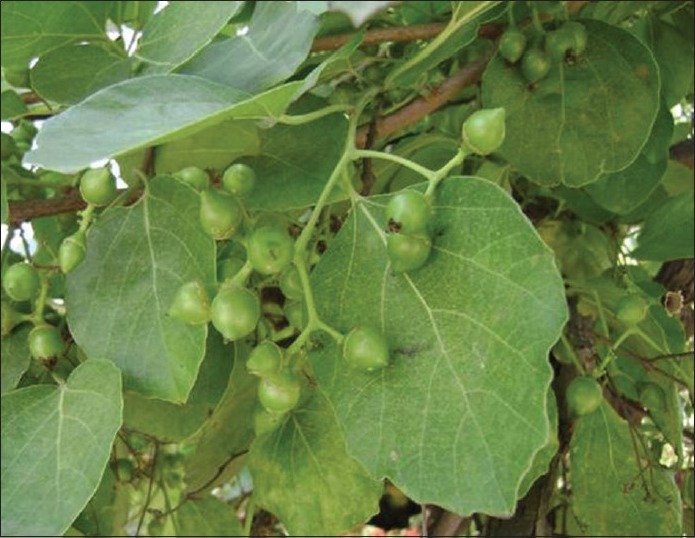
Leaves and fruits of Cordia dichotoma G. Forst
Table 1.
Percentage yield and physical characteristics of various extracts of Cordia dichotoma G. Forst. Leaf

Table 2.
Phytochemical screening of Cordia dichotoma G. Forst. leaf
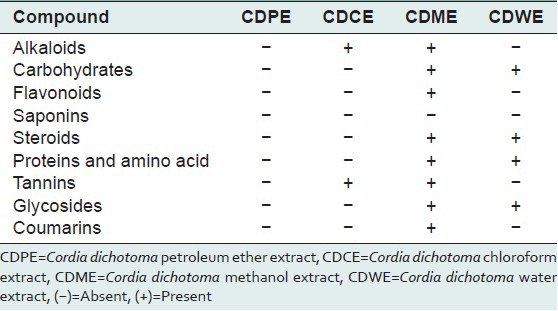
Figure 2.
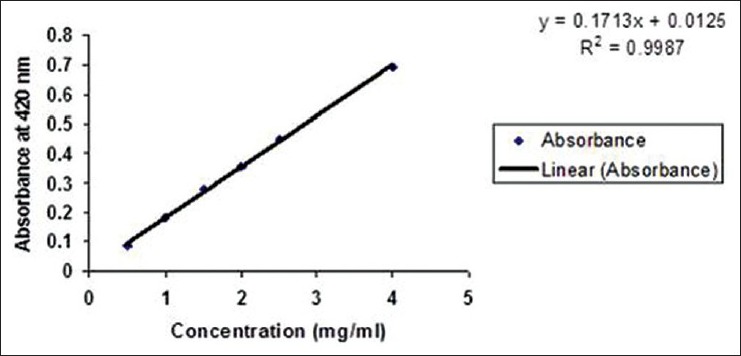
Standard plot of quercetin for the estimation of total flavonoid content
Figure 3.
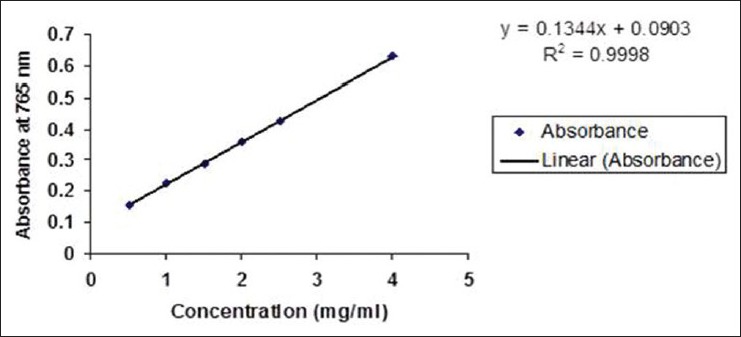
Standard plot of Gallic acid for the estimation of total phenolic content
Table 3.
Effect of CDME on Eddy's hot plate reaction time in rats

Figure 4.
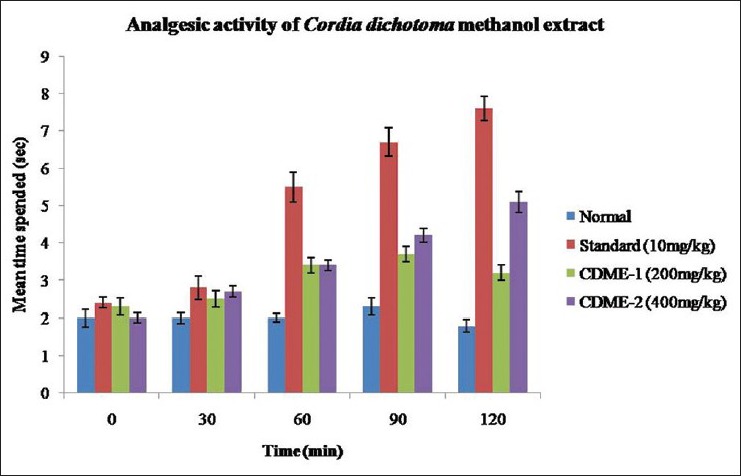
Effect of the CDME on hot plate reaction time in rats
Table 4.
Effect of the CDME on carrageenan induced paw edema in rats

Figure 5.
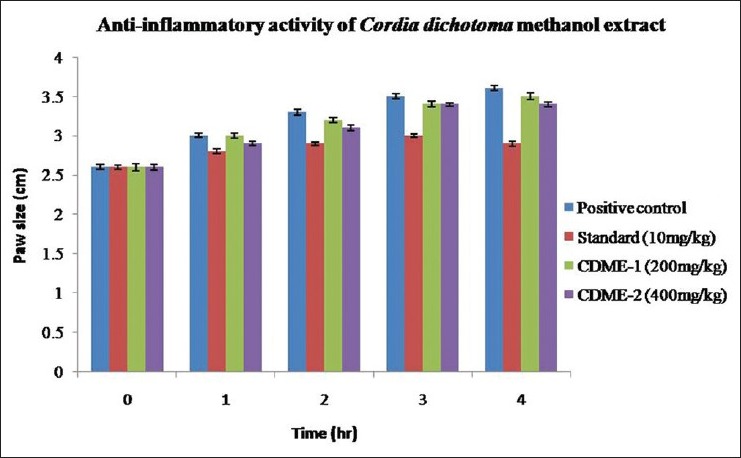
Effect of the CDME on carrageenan induced paw edema in rats
Table 5.
Effect of the CDME on induction of yeast induces pyrexia in rats

Figure 6.
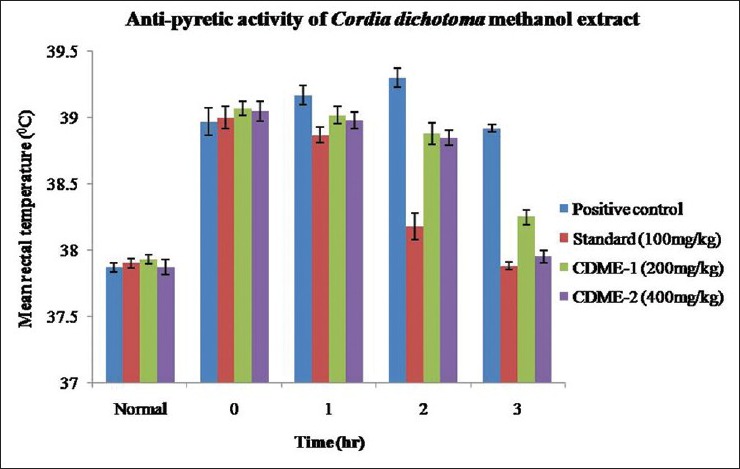
Effect of the CDME on induction of yeast induced pyrexia in rats
DISCUSSION
In this study, CDME showed positive results and its high dose (400 mg/kg) was found be highly significantly effective as analgesic, anti-inflammatory, and anti-pyretic drug compared to effects of low dose. Its anti-inflammatory potential was found lesser as compared to the other two effects. The effect of high dose was increasing with time, but the maximum time limit for its effects could not be elucidated because of the limited time of the study. This is the first study showing the antipyretic potential of C. dichotoma plant leaves.
CONCLUSION
In conclusion, the present study supports the traditional use of C. dichotoma G. Forst. leaves methanol extract as analgesic, antipyretic, and anti-inflammatory drug. However, the crude extracts of this plant need to be further purified through isolation and identification of the responsible compound for these above activities. The mechanism of action of C. dichotoma G. Forst. leaves may be another interested area to work in future.
ACKNOWLEDGMENTS
We are grateful to Dr. G. D. Gupta (Director) and college management for providing all necessary facilities and co-operation for doing this work. We also express our gratitude to whole faculty of ASBSJSM College of Pharmacy, Bela (Ropar), Punjab, for their support.
Footnotes
Source of Support: Nil
Conflict of Interest: None declared.
REFERENCES
- 1.Patel AK, Pathak N, Trivedi H, Gavania M, Patel M, Panchal N. Phytopharmacological properties of Cordia dichotoma as a potential medicinal tree: An overview. Int J Inst Pharm Life Sci. 2011;1:40–51. [Google Scholar]
- 2.Kirtikar KR, Basu BD. Indian Medicinal Plants. In: Basu L. M, editor. 2nd ed. Allahabad: Central Council for Research in Ayurveda and Siddha (Deptt of AYUSH, Min of Health and Family Welfare), Govt of India; 1933. pp. 2131–3. [Google Scholar]
- 3.Chopra RN, Nayar SL, Chopra IC. 1st ed. New Delhi: CSIR; 1956. Glossary of Indian medicinal plants, National institute of Science communication and information resources; p. 77. [Google Scholar]
- 4.Harborne JB. A guide to modern techniques of plant analysis. 3rd ed. UK: Chapman and Hall, ICMR; 1998. Phytochemical methods; pp. 89–131. [Google Scholar]
- 5.Evans WC. 16th ed. Saunders Elsevier: 2009. Trease and Evans Pharmacognosy; pp. 135–48. [Google Scholar]
- 6.Ordon Ez AL, Gomez JD, Vattuone MA, Isla MI. Antioxidant activities of Sechium edule (Jacq.) Swart extracts. Food Chem. 2006;97:452–8. [Google Scholar]
- 7.Sengul M, Yildiz H, Gungor N, Cetin B, Eser Z, Ercisli S. Total phenolic content, antioxidant and antimicrobial activities of some medicinal plants. Pak J Pharm Sci. 2009;13:102–6. [PubMed] [Google Scholar]
- 8.Purnima A, Koti BC, Thippeswamy AH, Jaji MS, Vishwantha AH, Kurhe YV, et al. Anti-inflammatory, analgesic and antipyretic activities of Mimuso pselengi Linn. Indian J Pharm Sci. 2010;72:480–5. doi: 10.4103/0250-474X.73908. [DOI] [PMC free article] [PubMed] [Google Scholar]
- 9.Vogel WH, Scholkens BA, Sandow J, Muller G, Vogel WF. 2nd ed. Berlin: Springer Verlag; 2002. Drug discovery and evaluation pharmacological assays; p. 696. 772. [Google Scholar]
- 10.Singh S, Raheja M, Sharma S. Analgesic activity on different extracts of Cordia dichotoma bark. Indian J Nat Prod. 2008;24:21. [Google Scholar]
- 11.Mustaffa F, Indurkar J, Ismail S, Mordi MN, Ramanathan S, Mansor SM. Analgesic activity, toxicity study and phytochemical screening of standardized Cinnomomum iners leaves methanolic extract. Pharmacognosy Res. 2010;2:76–81. doi: 10.4103/0974-8490.62952. [DOI] [PMC free article] [PubMed] [Google Scholar]
- 12.Okpo SO, Fatokun F, Adeyemi OO. Analgesic and anti-inflammatory activity of Crinum glaucum aqueous extract. J Ethnopharmacol. 2001;78:207–11. doi: 10.1016/s0378-8741(01)00318-x. [DOI] [PubMed] [Google Scholar]
- 13.Handunnetti SM, Kumara RR, Deraniyagala SA, Ratnasooriya WD. Anti-inflammatory activity of Ixora coccinea methanolic leaf extract. Pharmacognosy Res. 2009;1:80–90. [Google Scholar]
- 14.Dutta S, Das S. A study of the anti-inflammatory effect of the leaves of Psidium guajava Linn. on experimental animal models. Pharmacognosy Res. 2010;2:313–7. doi: 10.4103/0974-8490.72331. [DOI] [PMC free article] [PubMed] [Google Scholar]
- 15.Nisar M, Khan I, Simjee SU, Gilani AH, Obaidullah, Perveen OH. Anticonvulsant, analgesic and antipyretic activities of Taxus wallichiana Zucc. J Ethnopharmacol. 2008;116:490–4. doi: 10.1016/j.jep.2007.12.021. [DOI] [PubMed] [Google Scholar]


